

Networked Knowledge and Combinatorial Creativity. By Maria Popova Why creativity is like LEGO, or what Richard Dawkins has to do with Susan Sontag and Gandhi.
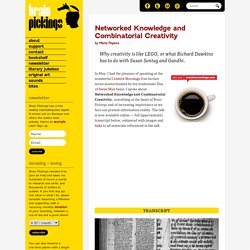
In May, I had the pleasure of speaking at the wonderful Creative Mornings free lecture series masterminded by my studiomate Tina of Swiss Miss fame. I spoke about Networked Knowledge and Combinatorial Creativity, something at the heart of Brain Pickings and of increasing importance as we face our present information reality. The talk is now available online — full (approximate) transcript below, enhanced with images and links to all materials referenced in the talk. These are pages from the most famous florilegium, completed by Thomas of Ireland in the 14th century.
In talking about these medieval manuscripts, Adam Gopnik writes in The New Yorker: Creativity. Creativity refers to the invention or origination of any new thing (a product, solution, artwork, literary work, joke, etc.) that has value.
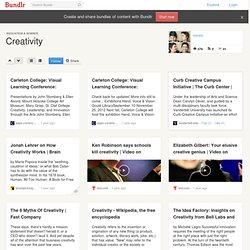
"New" may refer to the individual creator or the society or domain within which novelty occurs. "Valuable", similarly, may be defined in a variety of ways. [citation needed] [edit] Definition. Www.markfoster.net/struc/Mihaly_Csikszentmihalyi-wiki.pdf. Samples.sainsburysebooks.co.uk/9781743331958_sample_143766.pdf. PsycNET - Display Record. Www.jamesckaufman.com/wp-content/uploads/2012/08/Kaufman-Beghetto-2009-Beyond-big-and-little-The-four-c-model-of-creativity.pdf. Creativity. Creativity is a phenomenon whereby something new and valuable is created (such as an idea, a joke, an artistic or literary work, a painting or musical composition, a solution, an invention etc.).

The ideas and concepts so conceived can then manifest themselves in any number of ways, but most often, they become something we can see, hear, smell, touch, or taste. Definition[edit] In a summary of scientific research into creativity, Michael Mumford suggested: "Over the course of the last decade, however, we seem to have reached a general agreement that creativity involves the production of novel, useful products" (Mumford, 2003, p. 110).[1] Creativity can also be defined "as the process of producing something that is both original and worthwhile" or "characterized by originality and expressiveness and imaginative".[2] What is produced can come in many forms and is not specifically singled out in a subject or area.
Aspects[edit] Etymology[edit] History of the concept[edit] Ancient views[edit] PLASTIR/Deriaz2.pdf. Publications. Creativity is widely accepted as being an important outcome of schooling.
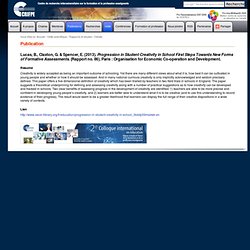
Yet there are many different views about what it is, how best it can be cultivated in young people and whether or how it should be assessed. And in many national curricula creativity is only implicitly acknowledged and seldom precisely defined. This paper offers a five dimensional definition of creativity which has been trialled by teachers in two field trials in schools in England. The paper suggests a theoretical underpinning for defining and assessing creativity along with a number of practical suggestions as to how creativity can be developed and tracked in schools.
Two clear benefits of assessing progress in the development of creativity are identified: 1) teachers are able to be more precise and confident in developing young people’s creativity, and 2) learners are better able to understand what it is to be creative (and to use this understanding to record evidence of their progress). Colloque créativité et apprentissage - Archives 2014 - Archives actu - Actualités et agenda. Dernière mise à jour le 27 mars 2014 Les UER Enseignement, apprentissage et évaluation et Didactiques de l'art et de la technologie de la HEP Vaud organisent un colloque sur la créativité et l'apprentissage les 15 et 16 mai 2014.
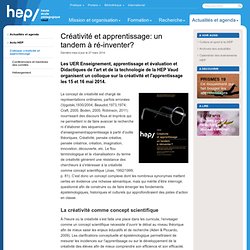
Le concept de créativité est chargé de représentations ordinaires, parfois erronées (Vygotski,1930/2004; Beaudot,1973,1974; Craft, 2005; Boden, 2005; Robinson, 2011) nourrissant des discours flous et imprécis qui ne permettent ni de faire avancer la recherche ni d’élaborer des séquences d’enseignement/apprentissage à partir d’outils théoriques. Créativité, pensée créative, pensée créatrice, création, imagination, innovation, découverte, etc. Le flou terminologique et la «banalisation» du terme de créativité génèrent une résistance des chercheurs à s’intéresser à la créativité comme concept scientifique (Joas, 1992/1999, p. 81).
La créativité comme concept scientifique Dépasser les conceptions réductrices de la créativité Quatre axes de réfléxion proposés Axe 1. Born Digital: Understanding the First Generation of Digital Natives - John Palfrey, Urs Gasser. Play, Creativity and Digital Cultures. Creativity for a New Curriculum: 5-11. Digital Creativity: Individuals, Groups, and Organizations - Kun Chang Lee. Creativity 101. Encyclopedia of Creativity. The de Bono Group - Interviews And Audio. We are pleased to organize this page around three key content vehicles related to the work of Dr.
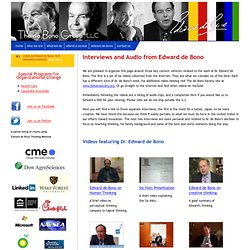
Edward de Bono. The first is a set of six videos collected from the internet. They are what we consider six of the best. Each has a different slice of Dr. de Bono’s work. For additional video viewing visit The de Bono Society site at www.debonosociety.org. Immediately following the videos are a listing of audio clips, and a completion form if you would like us to forward a DVD for your viewing. Next you will find a link to three separate interviews; the first is the need for a nation, Japan, to be more creative. Videos featuring Dr. Audio Below you will find additional audio portions of a DVD of Edward de Bono discussing creativity: Please note: DVD's will be sent to US addresses only. If you would like us to send you a copy of the DVD at no charge, please fill out the request form below, and include your name, full work address and telephone number. Creativity: Theories and Themes: Research, Development, and Practice - Mark A. Runco. Creativity: Theories and Themes: Research, Development, and Practice - Mark A. Runco.
Creativity in Education. Pédagogie de la créativité : de l’émotion à l’apprentissage. 1 Je remercie Nicolas Perrin pour sa lecture critique de mon texte. 1La perception que l’apprenant a de ses émotions et des manifestations physiologiques qui en découlent, a une influence très forte sur l’apprentissage et la réussite scolaire (Bandura, 1997/2007)1.
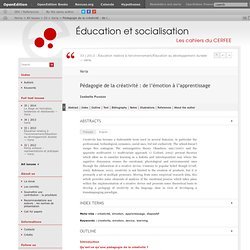
Ainsi, comment construire un environnement qui induirait des émotions facilitatrices d’apprentissage et qui réduirait ainsi les émotions parasites de l’apprentissage ? Quel pourrait être le rôle de la créativité dans ce processus ? 2 Nous ne savons pas encore si le terme de paradigme est le plus approprié ou s’il serait préférable (...) 2Une pédagogie de la créativité n’implique absolument pas de modification du programme. Pédagogie de la créativité : de l’émotion à l’apprentissage. 1 Je remercie Nicolas Perrin pour sa lecture critique de mon texte. 1La perception que l’apprenant a de ses émotions et des manifestations physiologiques qui en découlent, a une influence très forte sur l’apprentissage et la réussite scolaire (Bandura, 1997/2007)1.

Ainsi, comment construire un environnement qui induirait des émotions facilitatrices d’apprentissage et qui réduirait ainsi les émotions parasites de l’apprentissage ? Quel pourrait être le rôle de la créativité dans ce processus ? Www.cdc.qc.ca/ped_coll/v25/filteau-25-3-2012.pdf. Ife.ens-lyon.fr/vst/DA-Veille/70-janvier-2012.pdf. Www.revuedeshep.ch/site-fpeq/Site_FPEQ/11_files/07_schumacher.pdf. De l’importance d’intégrer la créativité dans l’enseignement fondamental – idcampus.be. Un mois et demi après la rentrée scolaire, nos petits ont enfin oublié les vacances pour retrouver la routine quotidienne de l’école.
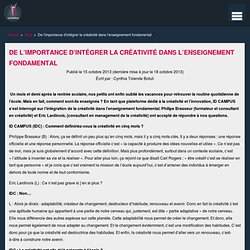
Mais en fait, comment sont-ils enseignés ? En tant que plateforme dédié à la créativité et l’innovation, ID CAMPUS s’est interrogé sur l’intégration de la créativité dans l’enseignement fondamental. Philipe Brasseur (formateur et consultant en créativité) et Eric Lardinois, (consultant en management de la créativité) ont accepté de répondre à nos questions. ID CAMPUS (IDC) : Comment définiriez-vous la créativité en cinq mots ?
Philippe Brasseur (B) : Alors, ça se définit un peu plus qu’en cinq mots, mais il y a cinq mots-clés. Eric Lardinois (L) : Ce n’est pas grave si j’en ai plus ? IDC : Non… Www.archipel.uqam.ca/3370/1/M9732.pdf. La créativité : l’enjeu n’est pas ce qu’on sait… Www.aqisep.qc.ca/archives/colloque/an2006/conference_gina_thesee/conference_Thesee.pdf. Introduction aux apprentissage essentiels communs - Table des matières. Wwwimages.adobe.com/content/dam/Adobe/en/education/pdfs/adobe-creativity-education-findings.pdf. Wwwimages.adobe.com/content/dam/Adobe/en/education/pdfs/barriers-to-creativity-in-education-study.pdf. What are the barriers to creativity in education? Wwwimages.adobe.com/content/dam/Adobe/en/education/pdfs/creativity-education-infographic.pdf.
RésuméCréativitéLori. Ken Robinson: "L'école anéanti la cérativité" TED est une petite association à but non lucratif qui consacre ses réflexions à des idées qui valent la peine d’être répandues.Au départ, il tentait de réunir des gens des technologies, du design et du divertissement, mais leurs champs d’expertise sont devenus de plus en plus grands.
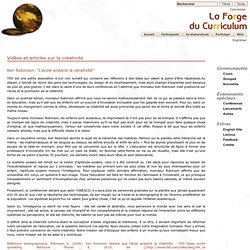
C’est dans le cadre d’une de leurs conférences en Californie que monsieur Ken Robinson s’est positionné sur l’école et la promotion de la créativité. Dans un premier temps, monsieur Robinson affirme que nous ne savons malheureusement rien de ce qui se passera dans le futur en éducation, mais qu’il sait que les enfants ont un pouvoir d’innovation incroyable que l’on gaspille bien souvent.
Pour lui, dans un monde en changement comme le nôtre, développer sa créativité est aussi primordial que savoir lire et écrire et devrait être traité au même niveau. Toujours selon monsieur Robinson, les enfants sont audacieux, ils improvisent ils n’ont pas peur de se tromper. Creative Web 2.0 Learning.
TaxonomieBloomTwiTter. TaxonomieBloomNumérique. Search Results. A major criticism I have of most educational institutions is that their primary focus is on students’ intellectual and cognitive development. Too often individual learner’s needs do not enter into the equation of their educations. Maslow’s Hierarchy of Needs is a useful model for educators to use to help insure that they are addressing more of the whole child. Applying Abraham Maslow’s theory of a pyramid-shaped hierarchy — physiological needs, personal safety, social affiliation, self-esteem and self-actualization — to education is an ideal way to assess lesson plans, courses and educational programs. By asking themselves whether these needs are being met in their school or classroom, educators can assess how well they are applying Maslow’s hierarchy to their teaching practice (How to Apply Maslow’s Hierarchy of Needs to Education).
Some general strategies for addressing these needs in the classroom can be found at Addressing Our Needs: Maslow Comes to Life for Educators and Students. Personal Learning Networks, CoPs Connectivism: Creatively Explained. As part of a graduate course in Social Network Learning, I ask students to create a non-linguistical representation. Here is the description of this assignment: The intent of this module is to assist you in developing a personalized and deep understanding of the concepts of this unit – the concepts that are core to using social networking as a learning venue. Communities of Practice, Connectivism, Personal Learning Networks, create one or a combination of the following to demonstrate your understanding of these concepts: a slide show or Glog of images, an audio cast of sounds, a video of sights, a series of hand drawn and scanned pictures, a mindmap of images, a mathematical formula, a periodic chart of concepts, or another form of nonlinguistic symbols.
Your product should contain the major elements discussed in this module: CoPs, Connectivism, and Personal Learning Networks. These are connected yet different concepts. Here are some samples from this term. A Powtoons Animation. Addressing Maslow’s Hierarchy of Needs with Technology. A major criticism I have of most educational institutions is that their primary focus is on students’ intellectual and cognitive development. Too often individual learner’s needs do not enter into the equation of their educations. Maslow’s Hierarchy of Needs is a useful model for educators to use to help insure that they are addressing more of the whole child. Applying Abraham Maslow’s theory of a pyramid-shaped hierarchy — physiological needs, personal safety, social affiliation, self-esteem and self-actualization — to education is an ideal way to assess lesson plans, courses and educational programs.
By asking themselves whether these needs are being met in their school or classroom, educators can assess how well they are applying Maslow’s hierarchy to their teaching practice (How to Apply Maslow’s Hierarchy of Needs to Education). Some general strategies for addressing these needs in the classroom can be found at Addressing Our Needs: Maslow Comes to Life for Educators and Students.